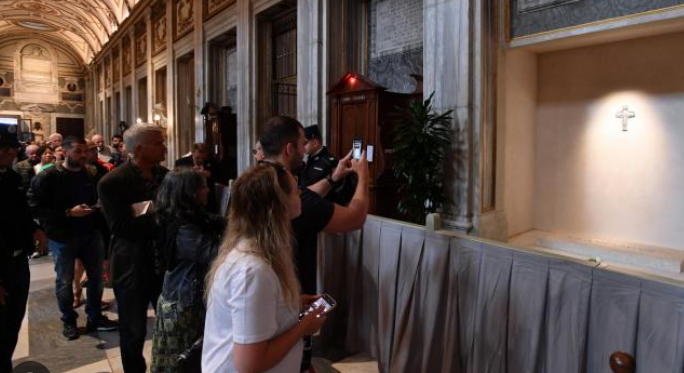Jamna Devi got her first cellphone about a year ago. It’s one of those with a tiny screen and a numbered keypad, the kind that are becoming increasingly rare in the age of Android and the iPhone. Devi’s village in India’s Rajasthan state is almost completely off the grid. It’s a sleepy cluster of houses in the middle of the desert. There’s one bus a day that passes through, the only connection to the nearest city more than 50 miles away.
She needs to climb onto the roof of her house to catch a couple of bars of cell service so she can call her children and relatives. “From there I can speak,” she said. “Sometimes it works. Otherwise this phone is just lying there useless.”
Like nearly 900 million people in India, Devi has never used a smartphone or accessed the internet. The race to bring those millions online, adding to more than 500 million Indians already connected to the internet, is being contested by the biggest global names in tech. And they’re shaping the future of the internet in the process.
Sources: United Nations, Nielsen, Telecom Regulatory Authority of India
“Little over half of the world’s population is online, which means about 3.5 billion people across the world are not connected to the internet,” Rajan Anandan, managing director of Google in India, told CNN Business last month.
So what will it take to connect those users and make the internet useful for them?
“Those answers lie… in what it would take to get the 900 million [Indians] who are not online,” Anandan said.
India has more unconnected people than any other country, and other features that make it the biggest opportunity in global tech today. China’s internet is largely closed off and Brazil has less than a fifth of India’s population. Africa, another massive market, has fewer people and the challenge of operating across an entire continent is much more complex.

Hundreds of millions of Indians are yet to experience the internet, and most will do so on smartphones. Dhiraj Singh/Bloomberg
India has already seen explosive growth in internet users, fueled by Silicon Valley’s rush to tap vast new markets and government investment in modernizing the country’s infrastructure.
Google (GOOGL) has helped set up free WiFi services at over 400 train stations across India, and also runs a digital literacy program to teach rural Indian women how to use the internet.
Facebook (FB) wants to set up 20,000 hotspots through its Express WiFi initiative that connects users for about 10 rupees ($0.14) a day. The government has a plan to install 250,000 hotspots in villages across India.
“To my mind, more than creating physical infrastructure we need digital infrastructure,” said Amitabh Kant, a senior policy adviser to the Indian government.
Source: Telecom Regulatory Authority of India
But arguably the biggest driver of India’s online boom has been a free internet gambit by the country’s richest man. Mukesh Ambani launched a new $20 billion mobile network, Reliance Jio, in September 2016, with an eye-popping inaugural offer. New customers were given six months of free 4G high-speed internet. That triggered a price war with other mobile providers slashing their rates dramatically.
Now, two years after it launched, Jio has built up a subscriber base of more than 250 million people. And Ambani predicts India will be “fully 4G” by 2020.
“Every phone in India will be a 4G enabled phone, and every customer will have access to 4G connectivity,” he said during a speech in October. “We are committed to connecting everyone and everything, everywhere.”
For Gorakh Dan, Jio has opened up a whole new world. The 26-year-old works as a stone supplier in the city of Jaisalmer, about 40 miles from Devi’s village. He got a Jio SIM card five months ago and then purchased his first smartphone, a Nokia, for about 5,000 rupees ($68). Dan is now obsessed with WhatsApp, which counts India as its biggest market, and YouTube.
He uses a quintessentially Indian expression to describe the impact Ambani’s company has had.
“Jio has become everyone’s father.”
India is already the world’s second-largest smartphone market, behind China, with more than 400 million users. But they represent less than a third of the population, and smartphone makers are racing to reach the rest.
Samsung and China’s Xiaomi now dominate the market, and both are only getting bigger — Samsung (SSNLF) built what it claims is the “world’s largest mobile factory” outside New Delhi earlier this year, while Xiaomi has tripled its capacity and can now produce two devices per second in India.
“Unlike the West and in China where people were offline, then online using desktops, then laptops, then mobile … people skip all these stages and go directly from not being online to being online via a smartphone,” Manu Jain, Xiaomi’s India head, said in an interview with CNN in May.
Prices matter

Sources: IDC Mobile Phone Tracker *2018 Q2
The main hurdle to getting online is the price of smartphones. Even the most affordable models are still out of reach for many Indians, who earn less than $2,000 a year on average. And Xiaomi just hiked prices because of a plunge in the value of the rupee.
With its pricey iPhones, Apple (AAPL) has struggled to gain a foothold, and currently accounts for barely 2% of India’s market. Chinese brands like Oppo and Vivo, on the other hand, have made huge inroads, but even their cheapest smartphones cost around 10,000 rupees ($137).
Google’s Anandan points out that even the most basic smartphones cost upwards of $60, while the keypad phones most Indians still use can be purchased for as little as $12.
“Tomorrow morning if I could wake up and have one wish for the Indian internet, I would say it would be a much more affordable quality smartphone,” he said. “If we could do that then I think literally overnight we could double the user base in India.”

Indians mainly use the internet to watch videos. Dominique Faget/AFP/Getty Images
The hundreds of millions of Indians that do own smartphones, meanwhile, are spoiled for choice as digital giants like Amazon (AMZN), Uber and Netflix (NFLX) battle it out with homegrown rivals such as Flipkart, Ola and Hotstar.
Amazon has earmarked at least $5 billion to expand its India business, and Uber has staked its future in Asia on the country after exiting China and southeast Asia. Netflix released its first Indian original series, “Sacred Games,” earlier this year, and has over a dozen more originals in the pipeline.
“India is one of the biggest markets for us,” said Jessica Lee, Netflix’s vice president of communications in Asia. “You look at the size of the population, internet penetration and the opportunity to grow — the challenge is how do you size this prize?”

India consumed almost 22% of the world’s mobile data between April and June 2018
22%

Data prices have plummeted (rupees per GB)
2016
206
($3)
2018
12
($0.16)
Sources: Telecom Regulatory Authority of India, Ericsson mobility report Q2 2018
The internet boom has also produced several Indian startups with multi-billion dollar valuations that are more than holding their own. Ola operates its ride-hailing service in about 110 Indian cities — 80 more than Uber. Flipkart controls an estimated 40% of India’s online retail market, compared to Amazon’s 32% share. And Paytm, India’s leading digital payments firm, has racked up more than 300 million users in eight years.
“We are companies that [have] generated in the internet age,” Paytm CEO Vijay Shekhar Sharma told CNN Business. “I think the internet will become the key driver of social and economic growth of this country.”
Other global players are expanding in India by pouring cash into the digital economy.
When Warren Buffett’s Berkshire Hathaway (BRKB) picked up a stake in Paytm this year — its first investment in an Indian company — it joined backers like Chinese tech giant Alibaba and Japan’s SoftBank, which also has a stake in Ola. Flipkart is now controlled by US retailer Walmart (WMT), which paid $16 billion for a 77% stake earlier this year.
Another big Chinese tech firm, Tencent (TCEHY), has stakes in both Flipkart and Ola. Disney (DIS) is in the process of getting its hands on India’s top streaming platform Hotstar and more than 75 million monthly active subscribers as part of its deal to buy most of 21st Century Fox (FOXA).
That heady mix of huge investment and rapid growth has turned India into a laboratory, spinning out ideas and products that will shape the internet way beyond India’s borders.
“The future is already here as far as India is concerned,” said Ankhi Das, Facebook’s director of public policy for South Asia.
There have been a series of “India first” products and features that have been rolled out to other countries.
Uber launched a “lite” low bandwidth version of its app in India earlier this year, while dating app Tinder debuted a feature in India that gives women more control over initiating a conversation. Both companies intend to roll out the features to other countries.
Facebook has been using India as a testing ground for years, having introduced a version of its website that worked on basic cellphones as far back as 2011. It has since released several other features and versions of its services in India, with mixed success.
“India is a very, very big priority for us,” said Das. “It has always been very core to our mission.”
India has had a big influence on companies in other ways. Amazon recently introduced a version of its app in Hindi, India’s most popular language, and plans to add other Indian languages in the near future.
Netflix first launched in India in January 2016, as part of a global expansion to 130 new countries. Less than a year later, it began allowing all its users around the world to download shows and watch them offline.

Netflix has more than a dozen Indian original series in the pipeline. Indranil Mukherjee/ AFP
While the download feature wasn’t exclusive to India, Lee said the country has played a major role in helping Netflix adapt to emerging markets. “Downloads, mobile compression, making file size smaller for videos so they are able to stream better, less buffering … all that comes from being in markets like India,” she added.
Google has been particularly proactive, introducing offline versions of YouTube and Google Maps and enhancing Google Translate to work better in India’s dozens of regional languages.
“In every single product what we’re seeing is when we actually build for India or when we actually tailor our products for these Indian users they tend to travel pretty well,” Anandan said.
Indians are even shaping the way the internet is used, including the cornerstone of Google’s business: search.
“These new users would much rather speak to the internet than tap or type so as a result, for instance, voice search queries in India are growing at 270% per year, which is staggering,” Anandan added. “We are already a video-first internet and if you ask me I would say that we will become the world’s first voice-first internet.”
India’s startups are also looking further afield. Ola has expanded to Australia, New Zealand and the United Kingdom in the past year. “India is a cut-throat market to operate in,” Anand Shah, Ola’s head of strategic initiatives, told CNN Business in early November. “If you can do it in India, you can do it anywhere.”
Paytm operates in Canada, and is partnering with SoftBank to launch online payments in Japan later this year. “Once we start to expand internationally, we definitely want to go into the US market,” Paytm’s Sharma said.
As the world’s second-largest online population, Indians are bound to have an outsized influence, says Kant. And unlike Chinese internet users, they’re using global platforms.
“The largest number of citizens on Twitter will be Indians, the largest number of citizens on Facebook will be Indian,” he said.
A Bollywood music label, T-Series, could soon have more subscribers on YouTube than any channel in the world.

India has more people under 25 than any other country, and tech companies are racing to bring them online. Amit Dave/Reuters
The frenzied pace of development is also throwing up regulations — and other enforced changes — that could shape how people experience the internet in other countries.
WhatsApp, for example, has been under fire for misinformation on its platform, which is used by more than 200 million Indians.
Viral hoax messages have been linked to mob violence across India in the past year, with false rumors of child abduction leading to more than a dozen lynchings. The government has repeatedly called out the Facebook-owned company for its role in spreading false information and has asked it to make changes to the way it operates.
WhatsApp has pushed back against some of the demands, including the ability to trace individual messages. But it has added labels that show when a message has been forwarded rather than composed by the sender, and limits on how many simultaneous chats a message can be forwarded to.
If you can do it in India, you can do it anywhere
Both those features were introduced in India and subsequently rolled out to the rest of the world. They have had “a significant impact” in reducing fake news and misinformation on the platform, Das said, adding that they have also proved effective in global scenarios such as Brazil’s recent election.
“I think the stability and growth of the internet is all going to be driven by how safe people feel on the internet,” she said.

Indians prefer to speak to their phones rather than type or swipe, and the country’s dozens of languages are a huge challenge. Rupak De Chowdhuri/Reuters
More regulations that are in the works could threaten India’s status as the global internet’s next frontier.
Restrictions on digital payments have already affected WhatsApp and Google, and proposed rules on e-commerce could hit Amazon’s India business. Global tech companies say draft legislation mandating that Indian user data be stored only in the country could slam the brakes on its rapid growth.
“I think data localization of any form slows down the internet economy and innovation in countries,” Google’s Anandan said. “We’re hoping that India will be progressive.”
The debate over regulation is critical for India’s digital economy, which has benefited greatly from China’s decision to keep most of its massive internet off-limits to global players.
The likes of Google and Facebook have been cut off from China’s 800 million internet users, leading them to pour enormous resources into India. Chinese companies are also taking advantage of India’s open economy, building commanding positions in smartphone sales and investing in the country’s top startups.
The real India that needs the internet… is not yet online
“I am extremely bullish … in terms of opportunity and the diversity that our country offers for any internet platform to be successful,” said Facebook’s Das.
Sharma, Paytm’s CEO, says global tech companies have been given too much freedom. He argues that those benefiting from the country’s internet boom have an obligation to store data in India. “Once our data is not going out of this country then we know who is consuming the data, what is it being used or not used for,” he said. “Your business is here, your consumers are here, the market is here. Why not?”

As more Indians get online, they will shape the way the internet is used around the world. Burhaan Kinu/ Hindustan Times via Getty Images
Whichever side the government comes down on, that market is only going to get bigger — and fast. Google’s Anandan estimates that India will hit 800 million users by 2022 at the latest. “So essentially we are three to four years away from having the user base that China has,” he said.
That means that for the tech industry, India is the world’s oyster.
“The reality is only 30% of India’s market is online today. The real India that needs the internet, that can benefit from the internet is not yet online,” Anandan added. “In many ways we are in day zero of the Indian internet.”
Rishi Iyengar is India editor for CNN Business, based in New Delhi.













Leave a Reply